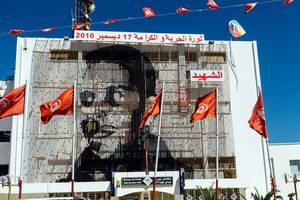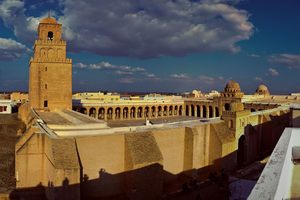About
As you wander the grounds of the Great Mosque of Kairouan in Tunisia you are treading across over a millennia of history. The magnificent structure — the oldest Muslim place of worship in Africa, founded in the year 670 — illustrates the mixed influences of pre-Islamic, Roman, and Byzantine architecture.
The city of Kairouan, Tunisia, has long been the Maghreb’s most ancient and holy city, a key gathering place for Arabo-Muslim civilization. The Great Mosque, also known as the Uqba Mosque, is at the heart of the city’s heritage. Standing at the nexus of 15 different thoroughfares, in the center of the country between the mountains and the sea, it is considered the fourth holiest site in Islam after Mecca, Medina and Jerusalem.
The structure is part of an expansive complex, the mosque itself covering 10,800 square meters (115,660 square feet). Within, there is a prayer room with 17 naves supported by carved columns, as well as the finely decorated mihrab, a special niche indicating the direction of mecca, outfitted in marble panels and luster tiles covered in floral patterns. There is also a pool, known as the Old Cistern (Al-Majal al-Qadim), and what is said to be the oldest surviving minbar—a finely carved wooden pulpit of Asian teak.
Outside, there is a decorated flagstone courtyard and towering, three-story minaret, reminiscent of Roman lighthouses. At 32 meters (104 feet), it remains one of the city’s highest structures. The mosque's architecture reflects features of pre-Islamic and Eastern Islamic art, as well as later Roman and Byzantine influences. The design has served as a model for many other Maghreb mosques.
The mosque was originally constructed by a general named Uqba ibn Nafi (also written as Sidi Okba) as a Friday Mosque (masjid-i jami` or jami`), used for communal prayers on the Muslim holy day. Though the structure built by Uqba no longer exists, the mosque we see today is sometimes still called “Mosque of Sidi Uqba” or simply, Uqba Mosque.
The mosque was rebuilt at least twice in the 8th century, and then again in the 9th century, when Prince Ziyadat Allah I, the Aghlabid governor, demolished most of the existing structure and rebuilt the mosque in sturdier materials of stone, brick, and wood. The surviving version includes a dome—borrowed from Roman and Byzantine architecture—and supporting buttresses, added in the 13th century.
The mosque sits between the city’s Rue de la Kasbah and the Rue el Farabi, in the historic walled district of the Medina. The holy structure is beautiful both during the day and at night, when the minaret is aglow with lights.
Related Tags
Know Before You Go
Opening hours are 8am-2pm Saturday-Thursday, and 8am-noon on Friday. Non-Muslims are not allowed in the prayer room, but the door is left open if you'd like to look inside.
Community Contributors
Added By
Published
June 17, 2016





















































































